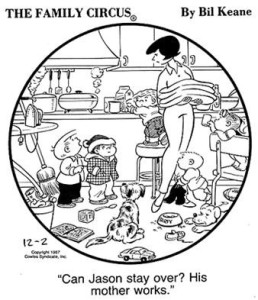Written by John Ellis, Director, Mecklenburg County CDSA
Take a look at this cartoon – cute, right? Look a little closer…what do you see? Does the chaos jump out at you first, and does it distract you from seeing the good things that are happening in the middle of it all? If you were working with this family, how would you describe them to a new team member?
For all eligible infants, toddlers and their families, Part C of the Individuals with Disabilities Education Act (IDEA) is intended to be an inclusive program. State and local early intervention agencies are obliged to enroll and serve all eligible children. The OSEP TA Community of Practice, Part C Settings: Workgroup on Principles and Practices in Natural Environments ( March, 2008) challenges us to think beyond our obligation to enroll all eligible children by proposing that all families, with the necessary supports and resources, can enhance their child’s learning and development.
While we may have always been willing to enroll every eligible child in early intervention, unfortunately, we have not always acted like we believe that all families can enhance their child’s development. Instead, we have all too often focused on what families aren’t doing more than on what they are doing, what they lack instead of what they possess, and our gauge for their capabilities has been whether or not they are capable of doing those things that we think they should be doing. In fact, we have been guilty at times of seeing families who aren’t doing what we think they should as being noncompliant. Why have we done this, and what makes such a simple-sounding statement like the one above so hard to believe, much less make happen? Here are some thoughts:
- We have a tendency to get in the way. We are professionals that have spent entire careers becoming experts in child development and disabilities. We have been taught to believe that we know what is wrong with children and what needs to be done to make things right. Because it makes perfectly good sense to us, we think it should make perfectly good sense to others. Our values about what is good or bad, right or wrong, start to creep in without even recognizing it, and before we know it, if we are not careful, all we can see is whether or not what we think needs to happen is happening. We lapse into thinking that we know what is best for families when we can’t think of what else to do.
- We have a really hard time believing that all families really are capable. Think about the family that you have struggled to work with recently. I was talking to a service coordinator this morning about a mother with three children, two under the age of three, who is homeless. They are living covertly with the children’s father in his subsidized housing, as he is not supposed to have any other permanent residents in his home. This mother is missing many service appointments, and yet continues to assert her desire for help. Situations like these have a tendency to make us see people as incapable, rather than seeing capable people in difficult situations. There is still a school of thought that we can help a child “overcome” their environment through enrichment activities provided out of context. These notions have pretty much proven to be wrong.
- We expect all families to be the same. Intellectually, we know that all families are not the same and that diversity is something to be valued and supported. Yet, we are often quick to think that all families should have the same care routines, the same child rearing practices, and the same play preferences. Having to realize that all families are different – and treat them as such – pushes us as professionals to think about different ways that the same outcome can be achieved by different families, based on their interests and preferences. In the short run, it makes our work more challenging; in the long run, it makes our work more successful.
We are all caring, well-intended professionals who want good results from our work with families. In spite of ourselves, we want to believe (and act like we believe) that all families, with the necessary supports and resources, can enhance their child’s learning and development. So what do we do?
- Embrace each family’s ability to support their child in the manner that they are intended to be supported. Assume that all families know what is best for their child and that what is supposed to happen will happen. Accept the family’s perception of what works and doesn’t work for them without judging its ultimate value. It may look unlike anything you have seen before, but if it works for the family, it is successful.
- Focus on family’s strengths without getting tripped up by their challenges. We are all limited in some way, but it doesn’t help us move forward to focus on our limitations. Use the family’s strengths in light of their reality to develop outcomes and strategies that will support the routines that they are able to address now. Avoid the temptation to try and “fix everything now” by moving at a pace that is comfortable and realistic for each family.
- Believe that every parent cares about their child and is doing their best to support him. How this looks is different in each family. When you find yourself thinking that a family can do better, tell yourself that they are doing the best they can for now. Resist the temptation to tell yourself that what they are doing is not best for the child, and tell yourself instead that they are doing the best they can for their child. This isn’t a rationalization that less than perfect is OK; it’s a realization that perfect is each family at their best.
I’ve often said that there is no such thing as a noncompliant family. Rather, there are times when we just aren’t clever enough to know how we need to engage a family. What do you think? Consider the cartoon at the beginning of the post again, and take specific note of the strengths that may be “hidden” because we may not be looking for them. The answer is out there for each family, we just have to keep looking – together – with them.







No comments yet.